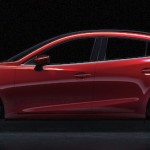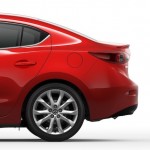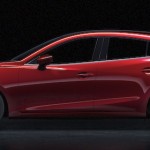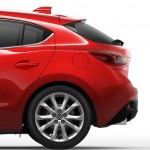
itself was voluntarily working towards cleaner-burning targets. Also, petrol and diesel would jump between 3-5c a litre under the July 2010 Emissions Trading Scheme. Carmakers have indeed regulated themselves in a bid to cut global warming exhaust gases. Average passenger car C02 in NZ is now 187.5gr/km, a drop since 2007 of 33 per cent, thanks to improved powertrain technology and the move towards smaller, lighter and more fuel-efficient cars. Take Mazda’s record over the past seven years. In 2007 its fleet average C02 was 232.4gr/km. Today it’s 181.3gr/km, a 35 per cent improvement. And there are more cleaner-burning gains to be made now that the new Mazda3 sedan and hatchback has arrived. Calling it a sedan is a little loose … it is more of a liftback/fastback. Mazda claims that the new 2.0- and 2.5-litre engines in the Mazda3 are 30 per cent more efficient than the same-sized outgoing units, thanks to its SkyActiv technologies, a bundle of fuel-efficiency stuff first seen in the CX-5 SUV. The old non-SkyActiv 2.0-litre unit in the Mazda3 was good for 8 litres/100km (187gr/km) and the 2.5-litre 8.6 litres/100km (204gr/km). The new 2.0-litre engine delivers town-and-around fuel use of 5.8 litres/100km (136gr/km), and the 2.5-litre 6.1 litres/100km (143gr/km). The 2.0-litre produces 114kW at 6000rpm and 200Nm at 4000rpm, and the 2.5-litre 138kW at 5700rpm and 250Nm at 3250rpm. Both can sound a little thrashy on an urgent throttle, not unusual for naturally aspirated four-cylinder units. The new direct-injection engines have ultra-high 13:1 compression ratios, which basically means a better bang when the fuel/air mixture ignites. Many carmakers are moving towards turbocharged small capacity engines to cut fuel use and emissions, but Mazda is marching to a different beat. It wants to exhaust existing automotive technologies before introducing electric devices to further improve fuel economy. It says real-world economy of the SkyActiv engines is, in most circumstances, superior to the smaller, boosted units – and believes it can wring even more efficiencies out of its SkyActiv stuff. The heartbeat of SkyActiv is more efficient combustion, improved cooling, a largely conventional six-speed automatic gearbox that’s lighter (and slicker) than most, and an improved exhaust manifold. The result is that more of the power in the fuel is used to drive the vehicle rather than being lost in the exhaust or cooling systems, or through mechanical resistance or friction. Both engines feature Mazda’s i-ELOOP system, which uses a capacitor to harvest kinetic energy to power the electrical systems for as long as a minute, its stop-start function helping to improve urban economy by up to 10 per cent as well as prolonging battery life. It uses no precious metals either, in contrast to hybrids. Mazda is the only recognised carmaker using capacitors (See below). The Mazda3’s SkyActiv platform is an all-steel monocoque construction, 60 per cent of which is either high or ultra-high strength and makes for a 30 per cent gain in torsional stiffness. This gain is immediately evident, especially on the throttle through twists and turns, where the car remained unruffled and consistent. The ride and handling might even be class leading, a blend of sweet chassis and crisp steering. Safety equipment is top drawer and includes an informative heads-up display on premium models. The new Mazda3 is a handsome critter, both as a hatch or sedan/liftback. It shows off the Kodo design language to best effect, including the sometimes awkward-looking Mazda family face, or grille. It is longer, wider and lower than the outgoing car, but with a 60mm-longer wheelbase. The cabin is simple, functional, likeable, and roomy enough. The dash is dominated by a screen showing MZD Connect, a multimedia function introduced in the Mazda3. Download the appropriate apps for your smartphone and the car integrates with it, giving access to internet radio, podcasts and social media. The Mazda3 is priced between $32,795 and $47,495. No difference in price between the sedan/liftback and hatch. There is a manual six-speed ‘box for those who like three pedals, the SP25 at $38,395. • Elon Musk, the founder of online service PayPal and US electric car company Tesla, believes capacitors, or rather high-energy super-capacitors, will replace batteries in electric vehicles. As a student, Musk moved from the US east coast to California’s Stanford University to research super-capacitors. That was before PayPal. Asked at a technology forum about the future of EVs, he said: “If I were to make a prediction, I’d think there’s a good chance that it is not batteries, but super-capacitors.” In EVs, super-capacitors would be much more efficient than batteries at storing the massive amounts of energy taken in during regenerative braking. But they would need a big surface area to be efficient. That’s where nano-technology comes in. Recent experiments have experts seeing a future where tiny conductive surfaces are buzzing with powerful electrons for rapid use. Just the ticket for EVs, they say.







